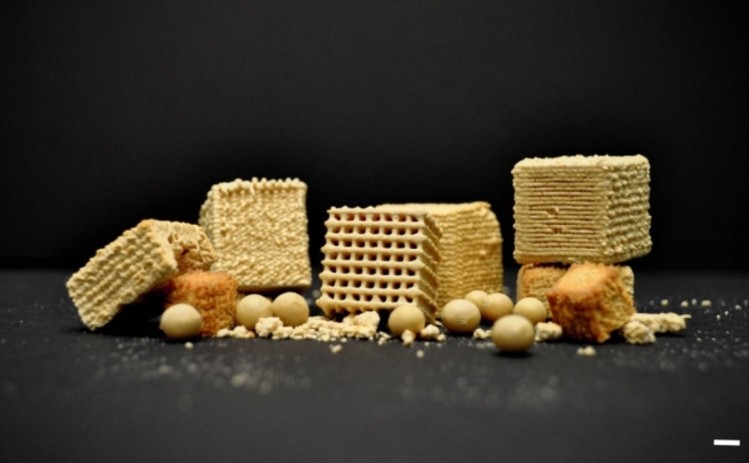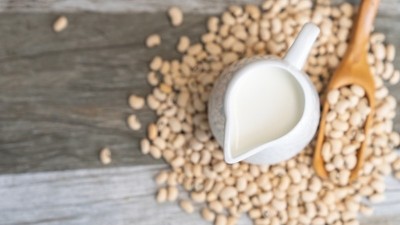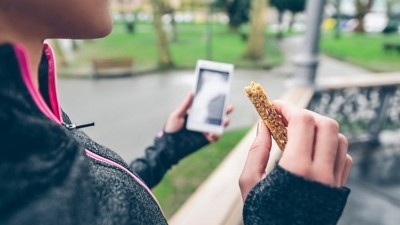Clean label ink: Researchers develop 3D printing method to create okara snacks with customised texture

Okara is a nutritious edible by-product from the production of soy milk and bean curd, typically discarded or used in animal feed despite its high amount of dietary fibre and protein.
Now researchers have taken these discarded okara powders to create clean label snacks through 3D printing.
Typically, in order to 3D print foods, the food inks used should have adequate rheological properties to ensure the mechanical integrity of the printed structures.
However, food additives such as xanthan gum, κ-carrageenan gum, locust bean gum, glycerol, and whey protein isolate are often added to modify the rheology, ensuring the smooth extrusion of the ink and preventing clogging of the nozzle when printing. They also tend to make the product thicker.
In this paper, researchers from Singapore and Japan identified the desired okara ink properties to print snacks with customised texture, without the need for additives.
They discovered that an ink with a combination of 33% w/w of okara powders and a particle sizes of <100 μm met the desired rheological properties with a yield stress of 200 ± 40 Pa. It also exhibited shear-thinning behaviour and maintained its shape upon deposition.
Okara snacks were then printed into cubes (20 mm × 20 mm × 20 mm) with different infill levels, to demonstrate different textures.
The infill levels were fixed at 25%, 50%, and 100%. 25% infill represented that the cube was filled with 25% of okara, and 100% infill represents that the entire cube was filled with okara.
The printed okara products were freeze-dried to serve as bite-sized snacks.
These snacks were then analysed for texture in terms of hardness, adhesiveness, cohesiveness, and springiness.
“As the infill of the 3D-printed okara increased, the hardness also increased from 17.33 ± 1.54 g (25% infill) to 47.00 ± 4.58 g (100% infill), researchers said.
“The increase in adhesiveness between sample with 25% infill to that with 100% infill suggested that an increased force is required to separate the okara that adheres to the teeth during consumption.
“We did not observe any significant difference in the springiness and cohesiveness for samples with three infill levels we investigated. These results have shown that the texture of food such as hardness and adhesiveness can be controlled effectively by varying the infill level of the 3D printed structures.”
All okara cubes held their structures without spreading and collapsing the printed inks. This observation confirmed the printability of 33% w/w of okara powders with particle sizes of <100 μm and was suitable to create 3D food structures.
Researchers said: “By 3D printing the food products, the textural properties such as hardness and adhesiveness can be controlled. Understanding the textural properties is important in defining the quality of food and human chewing behaviour. These attributes, in turn, are crucial aspects that can affect an individual sensation experienced during food consumption.
“The principle and method discussed in this study should apply to other edible materials, be it byproducts or not, which should drive potential applications of 3D food printing in healthcare and food sustainability.”
The team is now hoping to formulate different printable food inks, including for chocolate, milk, vegetables, and alternative proteins.
They are looking at other food grade waste that can be upcycled, include peels, seeds, and brewer’s spent grains.
“We successfully fabricated 3D structures with the food ink containing 33% w/w of okara powders in water with particle sizes of <100 μm. To the best of our knowledge, this is the first demonstration of 3D printing of okara without rheology modifiers.
“This work also highlights a unique route to upcycle the food waste (i.e., okara powders) into visually appealing snacks with customized texture, highlighting the potential use of 3D food printing to improve food sustainability,” they published in ACS Food Science and Technology.
Source: ACS Food Science and Technology
https://doi.org/10.1021/acsfoodscitech.1c00236
“3D Printing of Okara Ink: The Effect of Particle Size on the Printability”
Authors: Cheng Pau Lee, Masaki Takahashi, Satoshi Arai, Chi-Lik Ken Lee, and Michinao Hashimoto






















